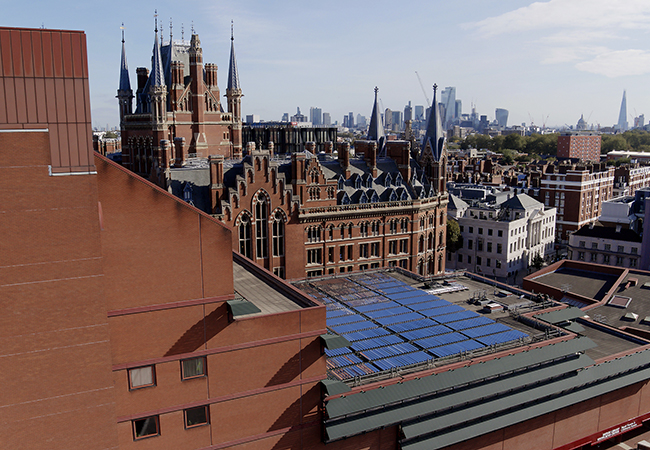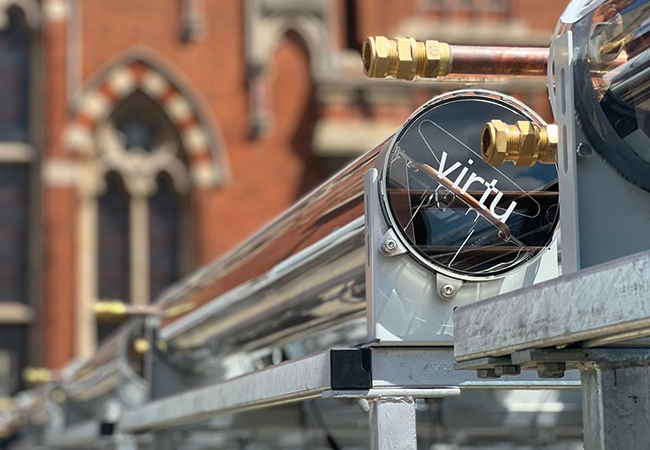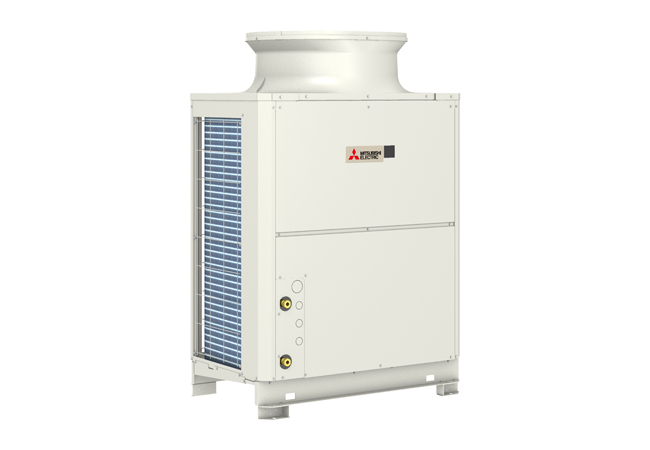
The narrative for the decarbonisation of the British Library will not be straightforward. To achieve its goal of net zero by 20501, it must substantially reduce carbon emissions from its existing buildings at St Pancras and Boston Spa, while also finding space for its rapidly expanding collection of more than 170 million items.
The script for decarbonisation at its existing sites has yet to be written, but the British Library has committed to reducing its energy use by 4% annually. This is particularly ambitious when you consider that this includes energy use at future new developments at St Pancras and Boston Spa.
Project team
Client: British Library
Solar thermal collectors: Naked Energy
Project manager: CBRE Global Workplace Solutions
Installer: Convert Energy
The British Library already has ongoing decarbonisation projects. One of these, at St Pancras, includes the installation of an innovative roof-top solar hot-water and power system, which went live last year.
The project involved the installation of 950 Naked Energy VirtuPVT and VirtuHOT collectors across 712.5m2 of the library’s roof space. VirtuPVT is a tubular hybrid solar collector that generates both electricity and heat from a single device, and VirtuHOT, is a solar thermal collector.
Readers may be familiar with the VirtuPVT as it won a CIBSE Building Performance Award in 2021, in the Product or Innovation of the Year – Thermal Comfort category.
The British Library is Naked Energy’s biggest project to date, and was made possible partly because of the low profile of the company’s collectors. This, according to Alex Mellor, Naked Energy’s director of engineering, helped the library win planning approval on its Grade I-listed roof. ‘It is important that the collectors are not visible from the street, and
that enabled us to get through planning,’ says Mellor. ‘We had to stay below the parapet, and our product is compact and has a very low profile of 26cm.’
The PV cells are also at an angle within the tube. Other solar solutions would have had to be tilted at an angle to work efficiently, Mellor says, and would have needed to be mounted on racks or A-frames, which would have made them visible from the street.
The Virtu collectors have also been designed to be resistant to wind. ‘We used a wind tunnel and CFD [computational fluid dynamics] analysis to understand the wind lift compared with other technologies,’ says Mellor.
‘Before we did this work, we thought that we wanted less air underneath the tubes to prevent wind lift, but it’s actually the opposite. The Bernoulli principle means that, if there is high velocity over the top, there will be static pressure underneath, lifting the collector. We created holes in the frame that allow the pressure to be equalised.’
This, however, raised the risk of creating access to nesting sites for London’s pigeon population, so Naked Energy designed the holes to be small enough to stop ‘bird ingress’.

Virtu’s absorbers are housed in an evacuated borosilicate glass tube
There are 240 hybrid and solar thermal collectors on the British Library scheme. Both types have a solar thermal flat plate absorber to heat water flowing through the system, which can be used for sanitary hot water or process heat up to 80˚C.
In the VirtuPVT collector, monocrystalline PV cells bonded to the absorber convert solar energy into electricity, with typical PV efficiency of around 20%. Each set of five hybrid tubes is equipped with a micro-inverter, which converts the DC electricity to AC electricity, to be used throughout the building.
The absorber is housed in an evacuated borosilicate glass tube, with the vacuum minimising thermal losses to ensure optimal heat output.
We used a wind tunnel and CFD analysis to understand the wind lift
According to Mellor, the system is suited to new or existing buildings. ‘Collectors can be integrated with heat pumps as part of the electrification of heat and hot water, or they can be specified to reduce gas consumption in situations where it is difficult to decarbonise or where it is being planned for the future,’ he says.
The British Library is in the latter category, as its heating, hot water and dehumidification systems are powered by gas. Under its sustainability strategy1, it has pledged to replace these with a heat pump system or connect to a local heat network.
Mellor says this range of collectors are most appropriate for commercial and industrial customers that have year-round heating consumption and, in particular, hot-water demand in the summer.
At the British Library, 1.4 million annual visitors create a large hot-water demand throughout the year, as does the heat-driven dehumidification system, which controls humidity to protect the books and manuscripts.
‘This big summer demand makes the project appropriate for such a system,’ says Mellor, who adds the heat from the collectors used in the summer is divided equally between hot water and the low temperature hot water (LTHW) feeding the dehumidification system. Solar heat from the collectors is also used for space heating in cooler months. In total, the installation supplies 4% of the library’s space heating and domestic hot water.
The British Library’s humidity control system uses steam and desiccant dehumidifiers. The heated water from the collectors contributes to the latter by heating air to 60°C, which then passes through the dehumidifier to drive out moisture.
Conventionally, this is done via a ‘space heating loop’ or LTHW headers, and as the Virtu system contributes to space heating, it is also connected to the desiccant dehumidification, says Mellor.
The solar hot water is stored in a giant 15m3 tank in the library plantroom. When heat is required in the building, it is taken from the solar tank preferentially, and any additional heat required is provided by the gas boilers.
The system uses an intelligent control system that tells the pumps when to run and the valves when to open, for maximum performance. It is remotely monitored to allow the library’s engineers to operate and maintain the system.
The collectors have Environmental Product Declarations, and Mellor says the carbon payback – in terms of embodied carbon and operational carbon savings – is between nine and 18 months.
While the British Library project is Naked Energy’s biggest to date, it does have other, even larger-scale ones – with wider applications – in the pipeline. They include a scheme that is twice the size of the British Library, and which has provision for cooling through an absorption chiller, as well as space heating and domestic hot water.
The company is also working on an integration project in Spain, where solar hot-water collectors are pre-heating a steam heat pump to achieve hot-water temperatures of 160°C.
As for the British Library, the system has generated 186MWh of thermal energy and 14.8MWh of electrical energy in the past 12 months, – which, happily, matches the predictions made at the system design stage.
References:
1 Sustainability and climate change strategy 2024-2030, British Library, October 2024, bit.ly/CJBLsus24


